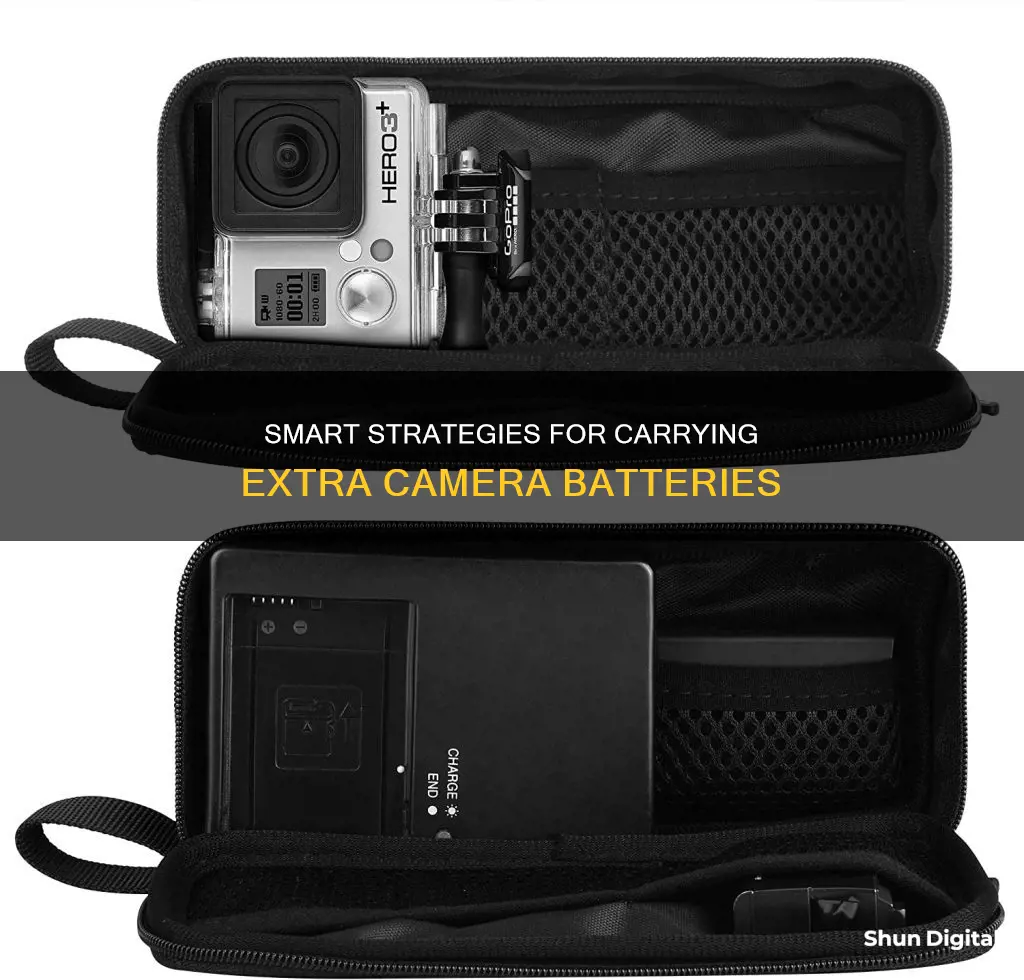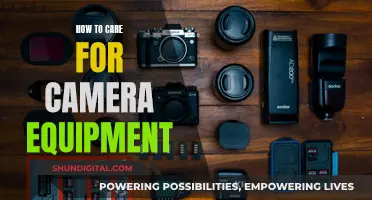
Carrying extra camera batteries is essential for photographers, especially when shooting outdoors or in cold weather. While some photographers use camera bags or pockets to store extra batteries, others prefer specialised battery holders or pouches that protect batteries from damage and make them easily accessible. When travelling by air, it is important to follow safety guidelines to prevent fire-related incidents. Spare lithium batteries, for example, are typically prohibited in checked baggage and must be placed in carry-on luggage. Additionally, covering battery contacts with tape can help prevent short circuits.
| Characteristics | Values |
|---|---|
| Carry-on baggage | Dry cell alkaline batteries; typical AA, AAA, C, D, 9-volt, button-sized cells, etc. |
| Dry cell rechargeable batteries such as Nickel Metal Hydride (NiMH) and Nickel Cadmium (NiCad) | |
| Lithium ion batteries | |
| Consumer-sized lithium ion batteries (no more than 8 grams of equivalent lithium content or 100 watt hours (wh) per battery) | |
| Up to two larger lithium ion batteries (more than 8 grams, up to 25 grams of equivalent lithium content per battery) | |
| Lithium metal batteries (no more than 2 grams of lithium per battery) | |
| Checked baggage | All the batteries allowed in carry-on baggage, except for spare (uninstalled) lithium batteries |
| Prohibited | Car batteries, wet batteries, or spillable batteries (unless being used to power a scooter or wheelchair) |
| Spare lithium batteries (both lithium metal and lithium-ion/polymer) |
What You'll Learn

Use a small camera case with a belt hook or loop
Using a small camera case with a belt hook or loop is a great way to carry extra camera batteries. This method ensures easy access to your batteries and keeps them secure while you're on the move. Here are some detailed tips on how to make the most of this storage solution:
Choose the Right Case
Select a small camera case that suits your needs. Look for one with a belt hook or loop, allowing you to conveniently attach it to your belt. Ensure the case is compact and lightweight, making it easy to carry around. The case should have enough room to store multiple batteries, memory cards, and other small accessories.
Organize Your Batteries
Keep your batteries organized within the case. You can use small plastic bags or pouches to separate fresh batteries from used ones. This helps you quickly identify which batteries need recharging and ensures you always have a fully charged battery within easy reach.
Protect Battery Contacts
Take steps to protect the battery contacts from short-circuiting. If possible, use the plastic caps that often come with new batteries. Alternatively, you can use electrical tape across the contacts or place each battery in its own protective case or pouch. This precaution will minimize the risk of a short circuit, which could lead to overheating or other issues.
Consider Additional Storage
In addition to the small camera case, you might want to bring a larger camera bag to store other gear and accessories. This bag can hold extra batteries, chargers, and other items you may not need as frequently. Having a separate small case for your most essential batteries ensures you can quickly access them without rummaging through a larger bag.
Follow Airline Guidelines
When travelling by air, be sure to follow the guidelines provided by the TSA and FAA. These guidelines include restrictions on the number and type of batteries allowed in carry-on and checked baggage. Always check the latest regulations before your flight to ensure you're complying with any updates.
Bayit Outdoor Camera: Is It Battery-Powered?
You may want to see also

Put batteries in your pocket
While it is not recommended to carry loose batteries in your pocket, you can carry a small pouch or wallet on your belt or in your pocket to store extra camera batteries. This is a good option if you don't want to carry a camera bag or if you want to keep your batteries separate from other items in your bag.
There are a few different types of pouches or holders that you can use to store your extra camera batteries. One option is a small camera case with a belt loop or hook that can hold two or more batteries. Another option is a battery holder specifically designed for DSLR batteries, which typically has multiple compartments to hold four or more batteries. These holders are usually made of nylon or other durable fabric and have a secure closure, such as Velcro, to keep your batteries in place. You can also find battery holders that are designed to attach to your belt, keeping your batteries easily accessible.
When choosing a pouch or holder for your extra camera batteries, consider the size and type of batteries you need to store. Some holders are designed for specific types of DSLR batteries, while others are more versatile and can accommodate a range of battery sizes. If you plan to carry the holder in your pocket, make sure it is small and compact. You may also want to look for features such as a secure closure to prevent the batteries from falling out and separate compartments to keep your batteries organized.
In addition to pouches and holders, there are a few other ways to carry extra camera batteries. One option is to use a camera bag with multiple pockets or compartments where you can store your batteries along with other accessories. Another option is to use a battery grip, which attaches to the bottom of your camera and holds additional batteries, extending your shooting time.
Whatever method you choose, it is important to handle and store your camera batteries properly to ensure their safety and longevity. Always follow the manufacturer's instructions for battery care and storage. Keep batteries away from extreme temperatures and do not carry them loose in your pocket with metal objects, as this can short-circuit the battery.
Charging Your Lumix Camera Battery: No Charger Required
You may want to see also

Use a camera bag
Using a camera bag is a great way to carry extra camera batteries and ensure they are protected and organised. Here are some tips on how to use a camera bag for carrying extra camera batteries:
- Choose a camera bag with multiple compartments: Look for a camera bag that has dedicated compartments for storing batteries and other small accessories. This will help you keep your batteries organised and easy to access.
- Use protective cases or pouches: Place each battery in its own protective case, pouch or plastic bag within your camera bag. This will help protect the battery terminals from short-circuiting and prevent damage to the batteries.
- Tape battery terminals: If your batteries do not have plastic covers, consider placing tape across the battery terminals to isolate them and prevent short-circuiting.
- Keep batteries in original packaging: If possible, store your spare batteries in their original retail packaging. This helps prevent unintentional activation or short-circuiting during transport.
- Secure loose items: Make sure that all loose items, such as battery chargers, are securely packed in your camera bag. Wrap any electrical cords tightly around the charger to avoid tangles and clutter.
- Avoid mixing battery types: Do not pack regular non-rechargeable batteries in a rechargeable battery charger. Non-rechargeable batteries are not designed for recharging and can become hazardous if placed in a battery charger.
- Follow airline guidelines: When travelling by air, always check the latest guidelines from the airline regarding the transportation of lithium-ion batteries. Some airlines may have specific requirements for covering battery terminals or restrictions on the number of spare batteries allowed.
Charging Your USB Spy Camera: A Quick Guide
You may want to see also

Use a battery wallet
Using a battery wallet is a great way to carry extra camera batteries. It is a compact and convenient solution for storing, protecting, and carrying your batteries. Think Tank Photo's DSLR Battery Holder, for instance, can hold up to four standard DSLR batteries and compresses flat when not in use, making it easy to store. It features a secure hook-and-loop closure with a top-fold design, ensuring your batteries stay in place.
Battery wallets are also available for different camera models, such as Canon and Sony. These wallets are designed to fit specific battery models, ensuring a snug fit. For example, a battery wallet for Canon LP-E6 DSLR batteries can hold up to five batteries, with one in the camera and four in the wallet. Similarly, a Sony A6500 battery wallet can hold multiple batteries due to their smaller size.
Battery wallets are an excellent way to keep your camera batteries organized, protected, and easily accessible. They are a must-have accessory for any photographer, ensuring you always have the power you need to capture the perfect shot.
Charging Waterproof Camera Batteries: Pentax Edition
You may want to see also

Use a battery holder
Using a battery holder is a great way to store and carry your extra camera batteries. Here are some tips on how to use a battery holder effectively:
Choose the Right Size
Select a battery holder that fits your battery size. Think Tank Photo offers battery holders that can carry up to four standard DSLR batteries. Make sure the holder is not too tight or too loose for your batteries.
Protect Battery Terminals
A good battery holder should have a secure closure to keep the batteries in place and protect the terminals from abrasion or damage. Think Tank Photo's DSLR Battery Holder 4, for example, features a hook-and-loop closure with a top-fold design, ensuring your batteries stay put.
Organize Your Batteries
Use the battery holder to organize and keep track of your charged and spent batteries. You can designate specific pockets for charged batteries and turn spent batteries upside down in their pockets. This way, you always know which batteries are ready to use.
Easy Storage and Transport
Battery holders are designed to be compact and easy to store. They can flatten when not in use, taking up minimal space in your camera bag or luggage. This makes them ideal for travel and everyday photography.
Durability
Look for a well-made battery holder with durable materials. Think Tank Photo's battery holder, for instance, is made of sturdy nylon fabric and has fine stitching. Such construction ensures your battery holder will last for years, protecting your batteries from bumps and scratches.
Value
While the value of a battery holder depends on your specific needs, some users have mentioned that the price of certain holders might be a bit high for what they offer. However, investing in a well-made battery holder can provide better protection and organization for your camera batteries.
Finding Your Camera Charger: Quick Solutions
You may want to see also
Frequently asked questions
You can use a small camera case with a belt hook or loop. Alternatively, you can use a DSLR battery holder, which can carry up to four standard DSLR batteries.
If you're travelling with spare batteries, consider placing each battery in its own protective case, plastic bag, or package, or place tape across the battery's contacts to isolate terminals. This prevents hazards due to short-circuiting.
Think Tank Photo and POWRIG both offer DSLR battery holders.
The TSA allows dry cell alkaline batteries, dry cell rechargeable batteries, lithium-ion batteries, and lithium metal batteries in carry-on bags. In checked bags, only spare (uninstalled) lithium batteries are prohibited.
Car batteries, wet batteries, and spillable batteries are prohibited from both carry-on and checked baggage unless they are being used to power a scooter or wheelchair.







